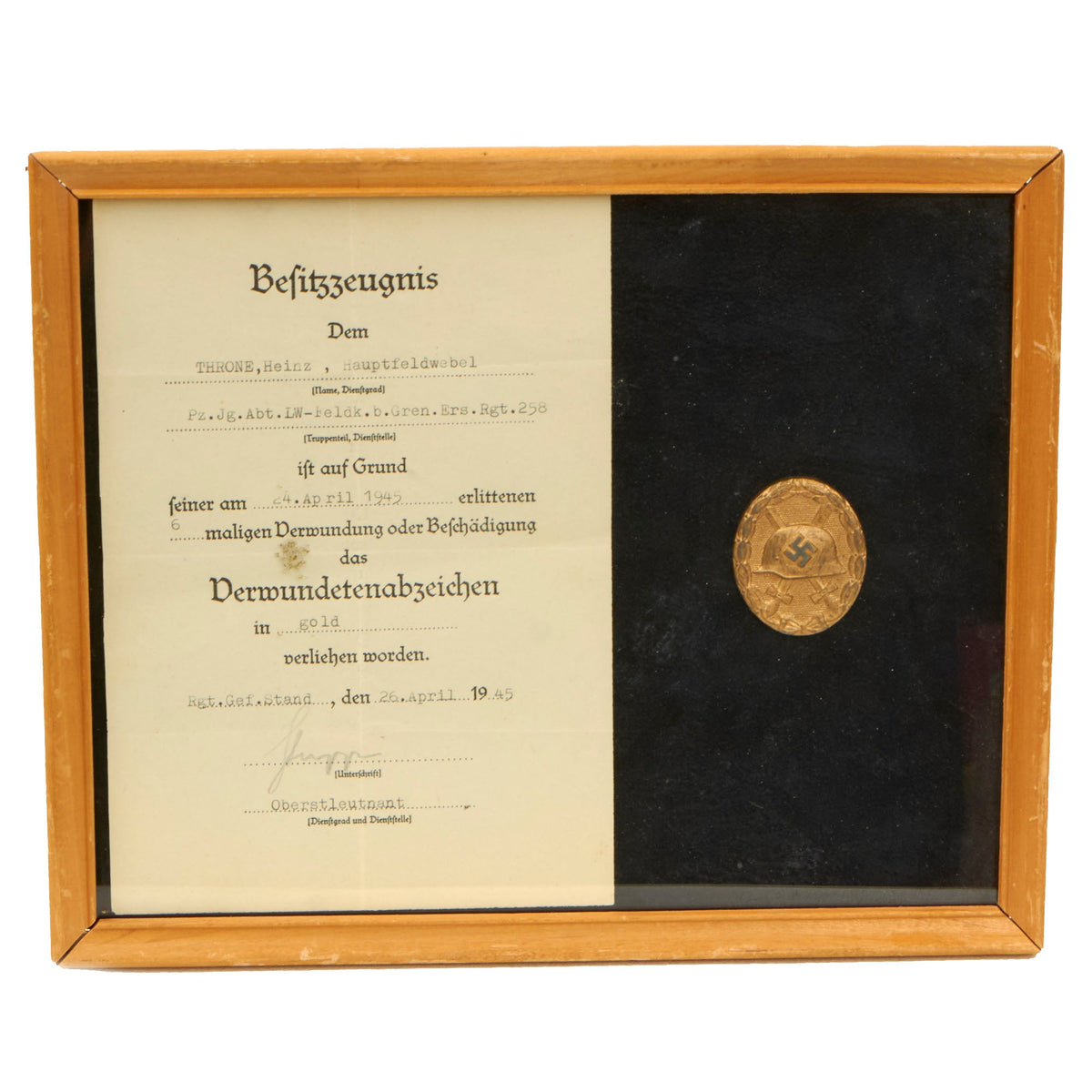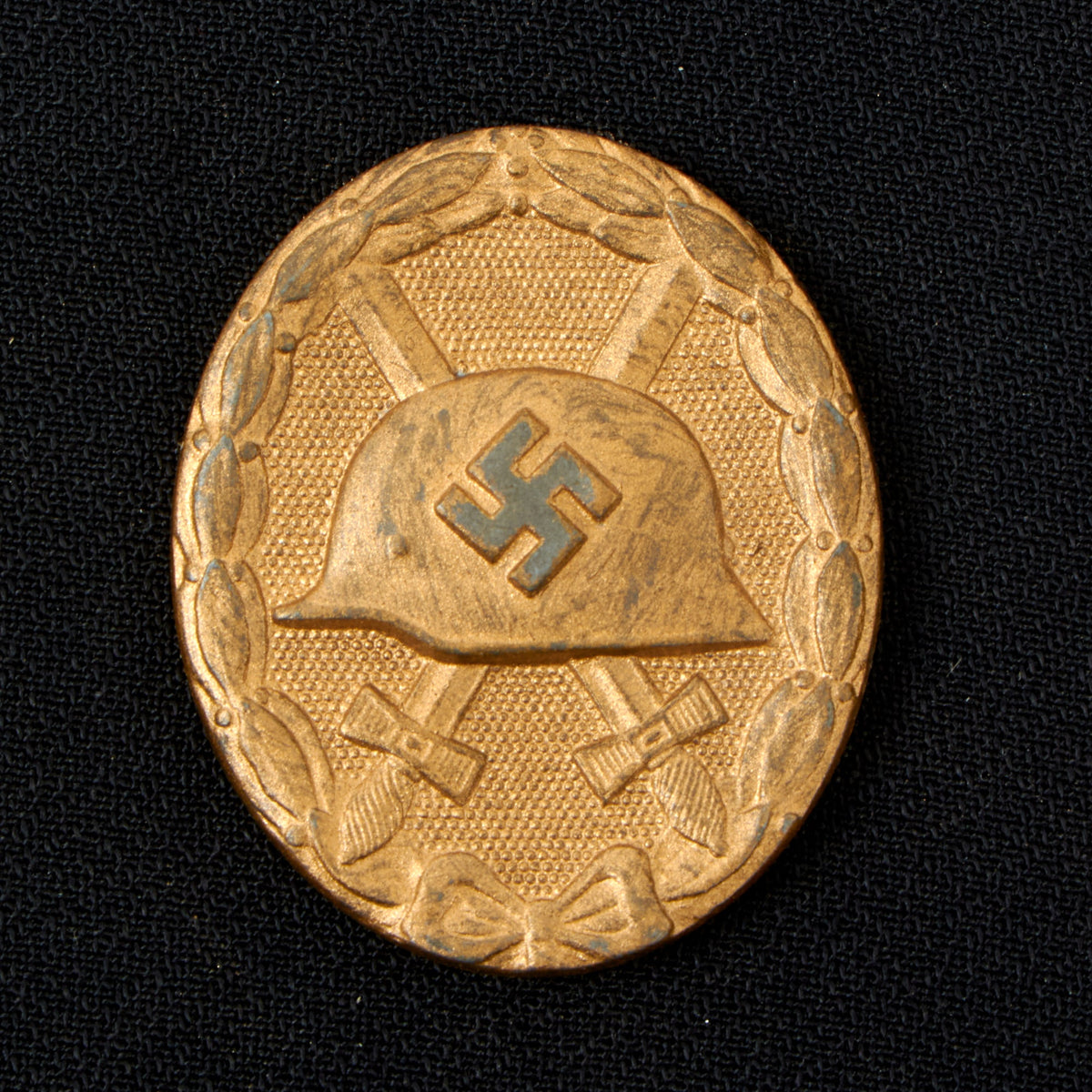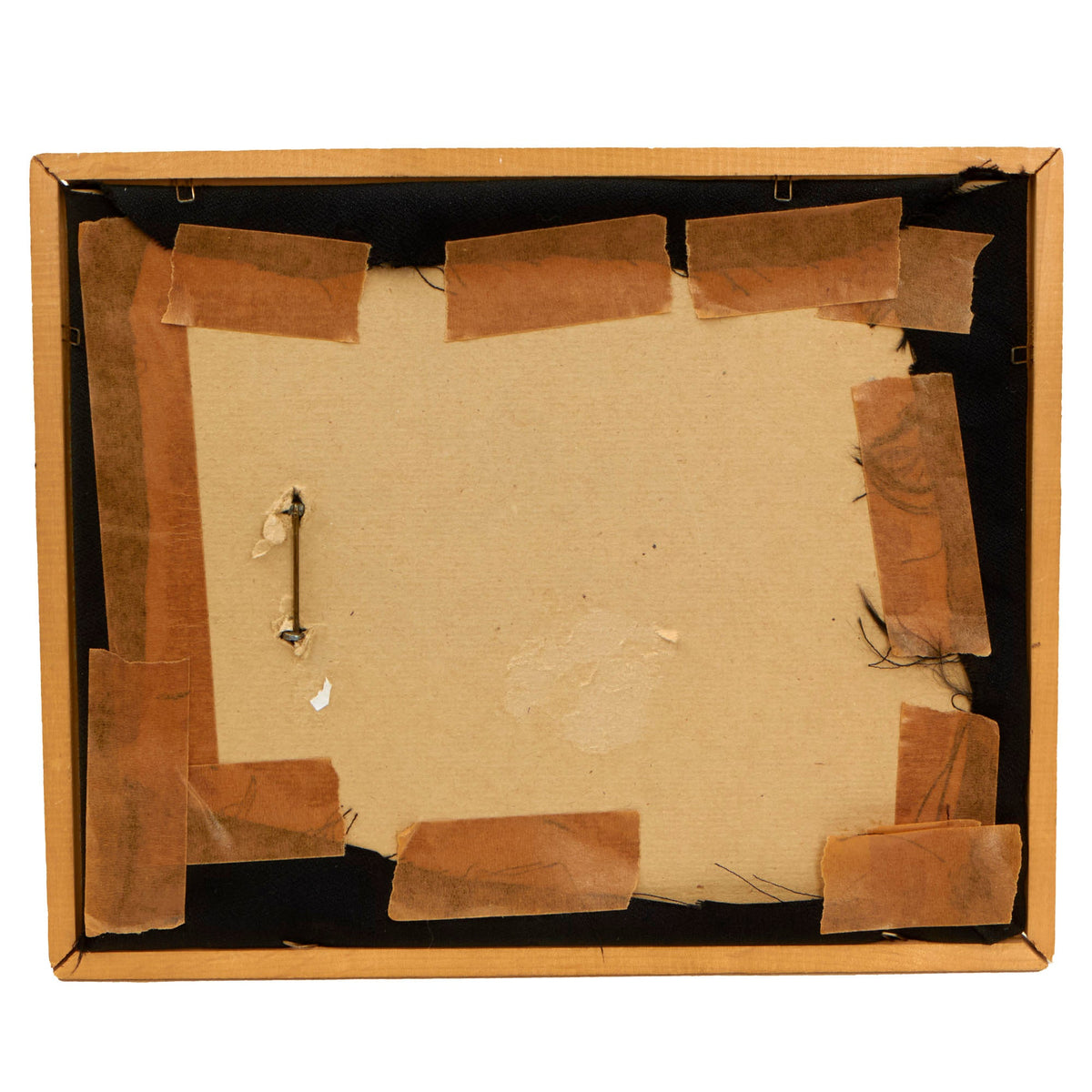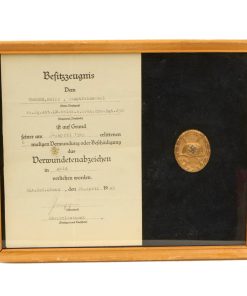Original German WWII Framed Gold 1st Class Wound Badge by B.H. Mayer’s Art Mint with Award Document – 10 ¾” x 8 ¾” Original Items
$ 295,00 $ 118,00
Original Item: Only One Available. This is a great example of a German WWII 1st class Gold wound badge (Verwundetenabzeichen in Gelb), with “solid back” zinc alloy construction, complete with its original Beſitzzeugnis “possession/award” certificate! The set is framed and glazed, though the frame could definitely use some adjustment as the backing is currently falling out.
Gold / 1st class badges, which could be awarded posthumously, were awarded to those wounded five or more times. The oval badge depicts an embossed profile of a mobile swas (hook cross), above an M35 pattern helmet, which is above two crossed broad swords. This then lies on a pebbled field and is surrounded by a laurel leaf and berry wreath which is tied together at the bottom with a bow tie. The badge measures 1.75 inches high by 1.5 inches wide.
The award document indicates that it was awarded to THRONE, Heinz, Hauptfeldwebel, which indicates they were an Unteroffiziere mit Portepee (Senior NCO) chosen to be the company commanders logistical assistant. They were usually an Oberfeldwebel (Master Sergeant), but could be other ranks. They were a member of the Pz. Jg. Abt. LW-Feldk. B. Gren. Ers. Rgt. 258, which indicates they were with a Panzerjäger Anti-Tank Gun Unit, probably using light weight field cannons. The end of the designation indicates they were an “Ersatz” or replacement unit. Definitely some good research potential here!
It was awarded on 26. April 1945 for a total of 6 injuries sustained as of 24. April 1945. The award was given at the Rgt. Gef. Stand, or the Regiment’s combat position, and is signed by an Oberstleutnant. The document has all the correct markings, and is the standard, 8″ x 5.5″, (20cm x 14cm), printed on lightweight paper with black print and typed in particulars.
The badge itself is in very good shape, retaining much of the gold wash on the obverse, while the reverse does not appear to ever have had a gold wash, and now shows an oxidized zinc patina. It is marked on the back with Präsidialkanzlei des Führers Lieferant (Presidential Chancellery Supplier) number 26, which represents B.H. Mayer’s Kunstprägeanstalt (Art Mint) of Pforzheim.
A very nice example, complete with document, ready to research and add to your collection!
The German Wound Badge (Verwundetenabzeichen) was instituted during the First World War to recognize those wounded in the conflict. It was designed using a World War One style Imperial German helmet as the main motif. The helmet was set on top two crossed swords against a pebbled background and surrounded by a laurel leaves wreath.
During the Spanish Civil War the Third Reich reinstated the Wound Badge for a short period to honor those who were wounded during the conflict from 1936 to 1939. These German units participating in the assistance of the Spanish Fascists were deemed the “Condor Legion”. The pattern of the World War One Wound Badge was again used, except this time with a raised swas on the center of the World War One era helmet.
At the outbreak of war in September 1939 with Poland, Adolf AH once again reinstated the Wound Badge Award. Again the pattern of the badge was similar to that of the earlier style except the new design was freshened up a bit by using an M35 pattern German helmet and a slightly softer looking wreath. This pattern was used until the end of the war in 1945. After March 1943, due to the increasing number of Allied bombings, it was also awarded to wounded civilians in air raids. It was awarded when the wound was the result of enemy hostile action, with an exception being for frostbite. It is impossible to know the exact numbers of wound badges awarded during the course of the Second World War due to the vast scale and countless individuals who were wounded or killed in the conflict.
The badge had three classes:
– Black (3rd class, representing Iron), for those wounded once or twice by hostile action (including air raids).
– Silver (2nd class) for being wounded three or four times.
– Gold (1st class, which could be awarded posthumously) for five or more times wounded.
The “progression” could be waived in the event of loss of a limb or eyesight; when such a severe wound occurred, the silver badge was awarded.
Badges were made of pressed steel, brass and zinc. All versions of the Wound Badge were worn on the lower left breast of the uniform or tunic. The badge was worn below all other awards on the left. It ranked lower than combat badges. There were 24 approved manufacturers of the Wound Badge. At first, the Wound Badge in Black was stamped from sheet brass, painted semi-matte black with a hollow reverse pin back attachment or of solid construction. From 1942, steel was used to make the badges. The Wound Badge in silver was made (before 1942) from silver-plated brass, and (after 1942) from lacquered zinc, and had a solid reverse with either a needle pin or a broad flat pin bar. The Wound Badge in Gold was a gilded version of the Wound Badge in Silver. In 1957, a revised version of the Wound Badge was authorised for wear; however, the previous type could still be worn if the swas were removed (for example by grinding).
Fast Shipping with Professional Packaging
Thanks to our longstanding association with UPS FedEx DHL, and other major international carriers, we are able to provide a range of shipping options. Our warehouse staff is expertly trained and will wrap your products according to our exact and precise specifications. Prior to shipping, your goods will be thoroughly examined and securely secured. We ship to thousands clients each day across multiple countries. This shows how we're dedicated to be the largest retailer on the internet. Warehouses and distribution centres can be located throughout Europe as well as the USA.
Note: Orders with more than one item will be assigned a processing date depending on the item.
Before shipping before shipping, we'll conduct a thorough inspection of the items you have ordered. Today, the majority of orders will be delivered within 48 hours. The delivery time will be between 3-7 days.
Returns
The stock is dynamic and we cannot completely manage it because multiple stakeholders are involved, including our factory and warehouse. So the actual stock may alter at any time. It's possible that you may not receive your order once the order has been made.
Our policy is valid for a period of 30 days. If you don't receive the product within 30 days, we are not able to issue a refund or an exchange.
You can only return an item if it is unused and in the same state as the day you received it. You must have the item in its original packaging.
Related products
Uncategorized
Uncategorized
Uncategorized
Armored Burgonet Helmet & Polearm from Scottish Castle Leith Hall Circa 1700 Original Items
Uncategorized
Uncategorized
Uncategorized
Uncategorized
Uncategorized
Uncategorized
Uncategorized
Uncategorized
Uncategorized
Uncategorized
Uncategorized
Uncategorized
Uncategorized
Angolan Rebel 1970s era 60mm Inert Display Mortar from Angolan Civil War Original Items
Uncategorized









































































